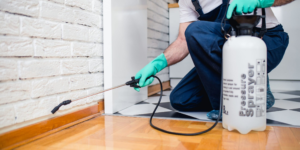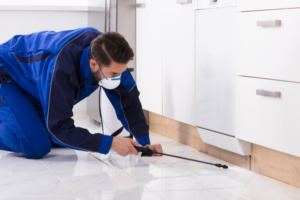Pest control is the process of reducing the population of a pest to an acceptable level. This can be achieved using a variety of techniques, some involving the use of chemicals.
It is important to remove sources of food, water and shelter for pests. This can be done by removing garbage regularly, fixing leaky pipes and practicing good sanitation. Click the Woodland Hills Pest Control to learn more.

The best way to control a pest infestation is to prevent it from occurring in the first place. Preventative measures include reducing the availability of food, water and shelter for pests by sealing cracks, cleaning up wood piles and keeping garbage cans tightly closed. Regular scouting can identify pest activity and help to determine the severity of the problem.
Using natural methods of control such as horticultural practices and biological controls is a wise approach to pest management. However, sometimes the use of chemicals is necessary and can be done in a responsible manner with Integrated Pest Management (IPM) principles. These strategies employ a gradual approach to pest management, starting with the least toxic options such as traps and physical barriers and gradually escalating to chemical treatments that are targeted and site specific, thus minimizing the risk of exposure to humans and beneficial organisms.
Properly installing screens can also help to deter pests such as flies, mosquitoes and ants from entering homes and businesses. The best screenings are those with a fine mesh that will stop larger insects from entering. Similarly, sealing gaps and cracks in home exteriors can be effective against pests such as mice and cockroaches. These can be done with expanding foam or caulk and should be done regularly to ensure the best results.
Providing pests with less accessible food, water and shelter will greatly decrease their desire to seek indoor refuge. This includes sealing the tiniest cracks in foundations, and making sure all doors and windows have properly functioning screens. Keeping garbage cans tightly sealed and removing them frequently from the property will reduce the number of pests attracted to trash and scraps. Likewise, fixing leaky faucets and drains will minimize the water sources available for pests.
Practicing good sanitation will also minimize the need for chemical pesticides. Thoroughly washing utensils and dishes after each use, and storing food in airtight containers can help to eliminate a variety of pests. Regularly cleaning the kitchen counters and floors will keep bacteria from growing that can attract pests such as ants, roaches, flies, mosquitoes and fruit flies.
Suppression
Pests are unwanted organisms that damage plants and crops, food supplies, buildings, and property. They also cause diseases to human beings and animals. Some examples of pests are rodents, ants, termites, and mosquitoes. Pest control is the process of eliminating these organisms. It involves identifying the type of pests, their severity, and the best methods to eradicate them. The process also includes monitoring pests and analyzing the effectiveness of the control measures.
Chemical pest control is the most common method for controlling unwanted pests. It involves applying pesticides or removing the environment that pests thrive in. This can include sealing cracks, fixing leaks, and cleaning up debris. However, it is important to remember that the chemicals used in pest control can be harmful to humans and the environment. Therefore, it is necessary to use them sparingly.
Biological pest control uses natural enemies to manage pest populations, such as predation and herbivory. It can also include the release of sterile insects or the use of pheromones. In addition, biological pest control can be accomplished using microbes such as bacteria, viruses, fungi, and nematodes.
Physical pest control uses traps and barriers to prevent the entry of unwanted organisms into an area. It can also include altering the environment through light, humidity, and temperature to reduce pest numbers.
Pest control is a vital service to protect the health and safety of people, pets, and livestock. It can help prevent bacterial infections, food contamination, and structural damage to homes and businesses. Routine pest control also helps preserve the value of a property. It is important to hire a professional pest control company to ensure that the job is done correctly and safely. A professional will understand the different methods of pest control and be able to choose the right ones for your situation. They will also be able to provide tips on how to prevent future infestations.
Eradication
Pest control is the process of eliminating unwanted insects, rodents and other organisms that can damage living spaces. It can also be the act of protecting food and water supplies. Different pests require different methods of control. For example, trapping works well for cockroaches but may not be effective against rodents. Biological pest control is one method that involves introducing predators, parasites or disease organisms that would otherwise occur in nature. This method reduces a pest population without harming the environment or other living organisms. Examples of biological pest control include nematodes, fleas and ticks.
Chemical pest control uses substances that poison or kill pests, and it is a useful tool in situations where physical controls aren’t feasible. Chemicals can be inhaled or ingested and can cause a range of health problems, including nausea, asthma and even death. For this reason, only licensed pest control technicians should use chemical pesticides and only in accordance with best practice codes. They should also be able to provide a Material Safety Data Sheet for the chemicals they use.
The term “eradication” has a specific meaning in the context of public health: “a permanent reduction to zero worldwide incidence of infection with a particular microbe, achieved through intervention.” This requires achieving two goals: controlling the reproductive rate (R) of the responsible organism and eliminating all its reservoirs. However, achieving this goal depends on a host of factors, including environmental conditions and the dynamics of populations of vectors, intermediary hosts and humans.
Some pesticides fail because pests develop resistance to the chemical. Other failures are the result of improper application or inadequate monitoring. When a pesticide fails, it’s important to determine the cause of the failure and fix the problem to prevent future infestations.
Safe pest control is a team effort. Building owners have a responsibility to maintain their buildings in good condition, and residents have a role to play by reporting pests and other maintenance issues to their landlords. Residents should always ask before hiring an outside pest control company and never allow a person to apply insecticides, pesticides or other hazardous substances in or around their home. Pesticides can cling to carpets and other surfaces, and they can be ingested or inhaled.
Monitoring
Pests can carry pathogens, allergens and other harmful substances that pose a risk to human health. Regular pest control keeps such risks at bay. It also preserves property values by preventing damage to buildings and their contents.
Prevention requires regular scouting and monitoring of premises for signs of pests, such as droppings, live insects and larvae, and rodent tracks and nests. A pest log keeps track of such observations, allowing technicians to pinpoint problem areas and take prompt action.
Using the results of scouting and monitoring to develop a pest management strategy, professionals can employ tactics such as biological, physical or chemical control methods to prevent problems from occurring. Threshold-based decision-making guides these decisions, enabling professionals to use the least disruptive approach in each situation.
Threshold levels refer to pest populations and conditions at which it is necessary to take control measures to avoid unacceptable damage or injury. For example, a few wasps around the house don’t warrant an immediate response, but a hive in the yard may require spraying.
Monitoring uses a variety of tools, including visual inspection, trapping, baiting and communication with employees who are in the area where the pests are most common. Adding attractants or pheromones can increase effectiveness. Species-specific pheromone traps have become popular in the areas of stored product pest (pantry pest) and ILT (indoor light trap) monitoring.
Pests often hide in dark harborages and crevices, making it difficult to detect them with a visual inspection. A flashlight can help to illuminate these locations, allowing a technician to inspect and identify pests more easily. Monitoring tools such as glue boards, rat bait stations and fly traps are also useful in detecting infestations early, especially when they are regularly inspected, augmented with specific attractants or pheromones and reported to the pest control program.
Integrated Pest Management (IPM) is an ecosystem-based strategy that monitors pests and their habitats, considers their role in wider food chains and their ecology, and applies the most effective control method to each situation. It avoids the overuse of harsh chemicals by targeting root causes, such as structural issues, sanitation and employee practices, rather than treating symptoms.

